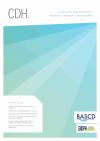Community Dental Health

- Cover Date:
- December 2018
- Print ISSN:
- 0265 539X
- Electronic ISSN:
- 2515-1746
- Vol:
- 35
- Issue:
- 4
Results of a two year dental health education program to reduce dental caries in young Aboriginal children in New South Wales, Australia
10.1922/CDH_4293Smith06
Objective: To assess the effectiveness of a dental health education program, ‘Smiles not Tears’ in preventing Early Childhood Caries in young Aboriginal children. Basic research design: Community trial. Clinical setting: Aboriginal Community Controlled Health Services in rural, remote and metropolitan areas in New South Wales, Australia. Participants: Aboriginal families who had a child six months of age. Interventions: Aboriginal Health Workers from eight Aboriginal Community Controlled Health Services in rural, remote and metropolitan areas in New South Wales recruited Aboriginal families with young children to participate in the Smiles not Tears dental education program. A convenience sample of Aboriginal children from the same communities was recruited to form a historical control group. Main outcome measures: The caries prevalence at 30 months of age compared to children of a similar age in the control group. Results: More children in the test group were caries free (n =104; 97.2%) when compared to the historical control group (n = 54; 65.9%). Only three children in the test group had caries which is less than the control group (n = 29). Conclusion: These results suggest that the Smiles not Tears dental education program has a positive impact on reducing the caries prevalence in young Aboriginal children.
Keywords: Children, dental caries, health promotion, Indigenous, prevention
- Article Price
- £15.00
- Institution Article Price
- £
- Page Start
- 211
- Page End
- 216
- Authors
- Smith L, Blinkhorn F, Moir R, Blinkhorn A
Articles from this issue
- Title
- Pg. Start
- Pg. End
- Understanding oral health care needs and oral health-related quality of life in vulnerable adults in Plymouth
- 197
- 200
- A feasibility study to explore the governance processes required for linkage between dental epidemiological, and birth cohort, data in the U.K.
- 201
- 203
- Results of a two year dental health education program to reduce dental caries in young Aboriginal children in New South Wales, Australia
- 211
- 216
- A multi-variable analysis of four factors affecting caries levels among five-year-old children; deprivation, ethnicity, exposure to fluoridated water and geographic region
- 217
- 222
- The impact of age and deprivation on NHS payment claims for domiciliary dental care in England
- 223
- 227
- Why might patients in the UK consult a general medical practitioner when experiencing dental problems? A literature review of patients’ perspectives
- 235
- 240
- Decision tree analysis for factors associated with dental caries in school-aged children in Japan
- 247
- 251
- Dentist’s views on incorporating oral health collaborative practice into primary medical care in Ireland
- 252
- 256
